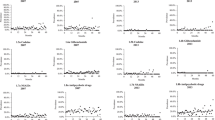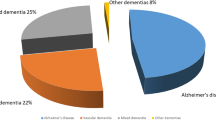Summary
There is little research investigating polypharmacy and potentially inappropriate medications (PIM) in connection with cognitive status in residents of Austrian nursing homes. Our findings result from a cross-sectional survey of 425 residents (315 women, 110 men, mean 83.6 years) from 12 Austrian nursing homes. The number of systemically administered permanent prescription drugs was 8.99 ± 3.9 and decreased significantly with increasing cognitive impairment. Irrespective of cognitive status, polypharmacy (> 5 individual substances) was present in approximately 75 % of the residents. Hyper-polypharmacy (> 10 individual substances) was present among almost 50 % of the cognitively intact residents, and hence, significantly more frequent as compared with the group with the lowest cognitive performance (23.4 %). At least one PIM was found in 72.4 % of residents regardless of cognitive status. Predominantly, PIMs consisted of tranquilizers, antipsychotics, osmotic laxatives, non-steroidal anti-inflammatory drugs (NSAIDs) and anticholinergics, where only the number of NSAIDs decreased significantly with increasing cognitive impairment. In summary, our study shows a continued high prevalence of polypharmacy and PIM in long-term care institutions in Austria.
Zusammenfassung
Die Datenlage zu Polypharmazie und potentiell inappropriaten Medikamenten (PIM) bei Bewohnern von österreichischen Langzeitpflegeeinrichtungen in Abhängigkeit vom kognitiven Status ist unzureichend. Unsere Ergebnisse resultieren aus einer Querschnitterhebung von 425 Bewohnern (315 Frauen, 110 Männer, mean 83,6 Jahre) in 12 österreichischen Altenpflegeheimen. Die Zahl der systemisch verabreichten Dauermedikamente betrug 9,0 ± 3,9 und sank mit zunehmender kognitiver Beeinträchtigung signifikant. Polypharmazie (> 5 Einzelsubstanzen) fand sich unabhängig vom kognitiven Status bei etwa 75 % der Bewohner. Hyperpolypharmazie (> 10 Einzelsubstanzen) war mit knapp 50 % bei den kognitiv leistungsfähigeren Bewohnern signifikant häufiger als in der Gruppe mit der geringsten kognitiven Leistungsfähigkeit (23,4 %). Mindestens 1 PIM fand sich bei 72,4 % der Bewohner ohne signifikante Unterschiede in Bezug auf den kognitiven Status. Unter den PIM dominierten Tranquilizer, Antipsychotika, osmotische Laxantien, nicht steroidale Antirheumatika (NSAID) und Anticholinergika., wobei lediglich die Zahl der NSAID mit zunehmender kognitiver Beeinträchtigung signifikant abnahm. Zusammenfassend zeigt unsere Studie eine anhaltend hohe Prävalenz von Polypharmazie und PIM in Einrichtungen der Langzeitpflege in Österreich.

Similar content being viewed by others
References
Statistik Austria 2013. Accessed June 2015. http://www.statistik.at/web_de/statistiken/menschen_und_gesellschaft/soziales/sozialleistungen_auf_landesebene/betreuungs_und_pflegedienste/index.html.
Onder G, Liperoti R, Fialová D, et al. Polypharmacy in nursing home in Europe: results from the SHELTER Study. J Gerontol A Biol Sci Med Sci. 2012;67A(6):698–704.
Doshi JA, Shaffer T, Briesacher BA, et al. National estimates of medication use in nursing homes: findings from the 1997 medicare current beneficiary survey and the 1996 medical expenditure survey. J Am Geriatr Soc. 2005;53:438–43.
Tjia J, Rothman MR, Kiely DK, et al. Daily medication use in nursing home residents with advanced dementia. J Am Geriatr Soc. 2010;58:880–8.
Onder G, Gambassi G, Scales CJ, et al. Adverse drug reactions and cognitive function among hospitalized older adults. Eur J Clin Pharmacol. 2002;58:371–7.
Vetrano DL, Tosato M, Colloca G, et al. Polypharmacy in nursing home residents with severe cognitive impairment: results from the SHELTER Study. Alzheimers Dement. 2013;9:587–93.
Holt S, Schmiedl S, Thürmann PA. Potentially inappropriate medication in the elderly—PRISCUS list. Dtsch Arztebl Int. 2010;107:543–51.
Mann E, Böhmdorfer B, Frühwald T, et al. Potentially inappropriate medication in geriatric patients: the Austrian consensus panel list. Wien Klin Wochenschr. 2012;124(5–6):160–9.
Fialová D, Topinková E, Gambassi G, et al. Potentially inappropriate medication use among elderly home care patients in Europe. JAMA. 2005;293(11):1348–58.
Mann E, Haastert B, Böhmdorfer B, et al. Prevalence and associations of potentially inappropriate prescriptions in Austrian nursing home residents: secondary analysis of a cross-sectional study. Wien Klin Wochenschr. 2013;125:180–8.
WHO 2010. The anatomical therapeutic chemical classification system. Accessed Nov 2010. http://www.whocc.no/atc_ddd_index/.
Kaiser A, Gusner-Pfeiffer R, Griessenberger H, et al. Mini-Mental-State—Ein Screening in vielen Versionen. Z Gerontopsychol Psychiatr. 2009;22:11–6.
Dwyer LL, Han B, Woodwell DA, Rechtsteiner EA. Polypharmacy in nursing home residents in the United States: results of the 2004 National Nursing Home Survey. Am J Geriatr Pharmacother. 2010;8(1):63–72.
Bronskill SE, Gill SS, Paterson JM, et al. Exploring variation in rates of polypharmacy across long-term care homes. J Am Med Dir Assoc. 2012;13(3):309.e15–21.
Colloca G, Tosato M, Vetrano DL, Topinkova E, et al. Inappropriate drugs in elderly patients with severe cognitive impairment: results from the shelter study. PLoS One. 2012;7(10):e46669.
Cool C, Cestac P, Laborde C, et al. Potentially inappropriate drug prescribing and associated factors in nursing homes. J Am Med Dir Assoc. 2014;15(11):850.e1–9.
Mann E, Köpke S, Haastert B, et al. Psychotropic medication use among nursing home residents in Austria: a cross-sectional study. BMC Geriatr. 2009;9:18.
Morrison RS, Siu AL. A comparison of pain and its treatment in advanced dementia and cognitively intact patients with hip fracture. J Pain Symptom Manage. 2000;19:240–8.
Closs SJ, Barr B, Briggs M. Cognitive status and analgesic provision in nursing home residents. Br J Gen Pract. 2004;54(509):919–21.
Cornali C, Franzoni S, Gatti S, et al. Diagnosis of chronic pain caused by osteoarthritis and prescription of analgesics in patients with cognitive impairment. J Am Med Dir Assoc. 2006;7(1):1–5.
Garfinkel D, Mangin D. Feasibility study of a systematic approach for discontinuation of multiple medications in older adults. Arch Intern Med. 2010;170:1648–54.
Holmes HM, Sachs GA, Shega JW, et al. Integrating palliative medicine into the care of persons with advanced dementia: identifying appropriate medication use. J Am Geriatr Soc. 2008;56:1306–11.
Author information
Authors and Affiliations
Corresponding author
Ethics declarations
Conflict of interest
R. Alzner, U. Bauer, S. Pitzer, M. M. Schreier, J. Osterbrink, and B. Iglseder declare that there are no actual or potential conflicts of interest in relation to this article.
Rights and permissions
About this article
Cite this article
Alzner, R., Bauer, U., Pitzer, S. et al. Polypharmacy, potentially inappropriate medication and cognitive status in Austrian nursing home residents: results from the OSiA study. Wien Med Wochenschr 166, 161–165 (2016). https://doi.org/10.1007/s10354-015-0428-8
Received:
Accepted:
Published:
Issue Date:
DOI: https://doi.org/10.1007/s10354-015-0428-8




